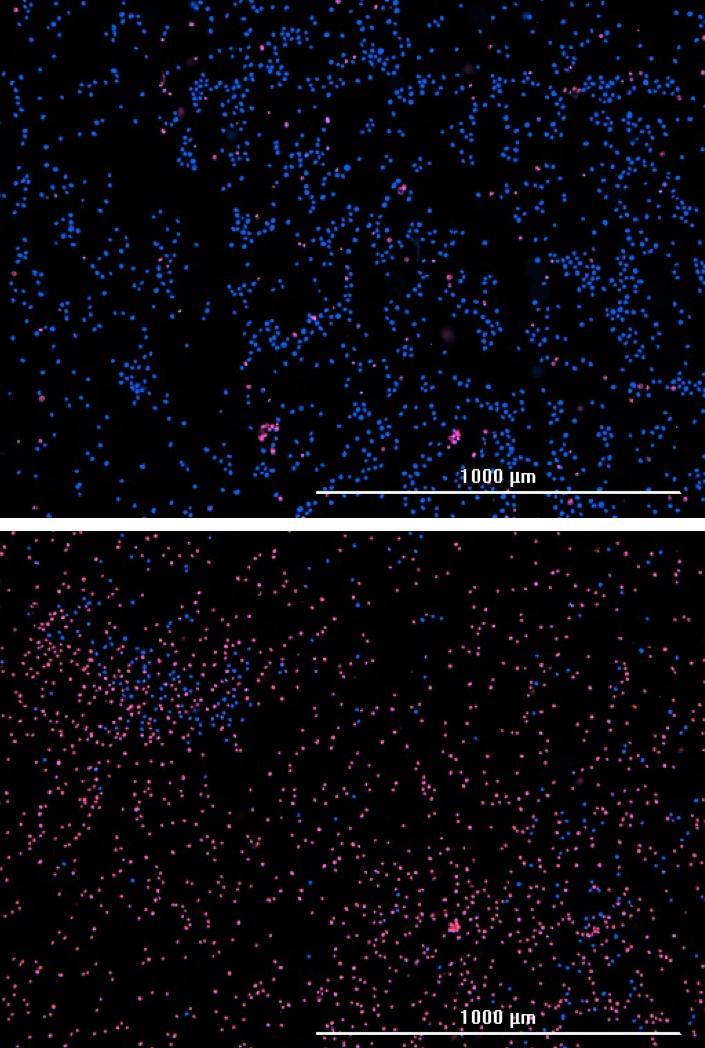Rice University, MD Anderson research points toward better personalized therapy

Credit: Kirienko Lab/Rice University
HOUSTON – (Oct. 31, 2019) – A combination of drugs that affect mitochondria — the power plants inside cells — may become the best weapons yet to fight acute myeloid leukemia, according to Rice University researchers.
A study led by Rice bioscientist Natasha Kirienko and postdoctoral researcher Svetlana Panina found that mitocans, anti-cancer drugs that target mitochondria, are particularly adept at killing leukemia cells, especially when combined with a glycolytic inhibitor, while leaving healthy blood cells in the same sample largely unaffected.
Their open access paper, a collaboration with the University of Texas MD Anderson Cancer Center, appears in the Nature journal Cell Death & Disease. The research could lead to new ways to personalize treatment for patients with leukemia.
“We started with the idea of finding an underlying connection between types of cancer and their sensitivity to specific kinds of chemotherapeutics, mitochondria-targeting drugs,” Kirienko said. “Our bioinformatic analysis, which included 60 cell lines from nine different cancer types, showed that leukemia cells are particularly sensitive to mitochondrial damage.”
The researchers exposed the cell lines to multiple known mitocan molecules. They found low doses of a mitocan/glycolytic inhibitor cocktail killed all of the leukemia cell lines they tested at concentrations lower than what was necessary to kill healthy cells. Conversely, they reported that solid tumor cells, like ovarian cancers, proved highly resistant to mitocans. Glioblastoma cells were sensitive to mitocans, but unfortunately more resistant than healthy blood cells.
In their best experimental results, 86% of targeted leukemia cells were killed, compared to only 30% of healthy blood cells. “A number of drugs currently used in the clinic have some cancer preference, but here we’re talking about a five-fold difference in survival,” Kirienko said.
The researchers also showed a significant correlation between how efficiently mitochondria can turn energy from incoming oxygen into useful adenosine triphosphate (ATP) and how resistant they are to treatment.
“The more efficient they are, the more resistant they will be to mitochondria-targeting drugs,” Kirienko said. “If this holds true, doctors can perform a relatively simple test of this specific parameter of mitochondrial health from a patient’s sample and predict whether the treatment would be effective.”
Panina said computational models led them to think the glycolysis pathway could be enlisted to help mitocans. “Glycolysis also provides ATP, so targeting that will decrease energy as well as block the precursor for energy production in mitochondria, which mitocans will exacerbate further,” she said. “It led us to believe this combination would have a synergistic effect.
“Cancer cells are usually more metabolically active than normal cells, so we predicted that they be might be more sensitive to this combined strike, and they are,” Panina said.
Kirienko said a presentation of the research she and Panina gave at MD Anderson’s recent Metabolism in Cancer Symposium drew a large response. “People were very interested, and they immediately started asking, ‘Did you test my favorite drug or combination?’ and ‘Are you going to test it in a wider panel of cancers?'”
That work is well underway, Panina said. “We’re currently doing high-throughput screening of these potential synergistic drug combinations against leukemia cells,” she said. “We’ve gone through 36 combinations so far, building landscapes for each one.”
“And we found some that are more effective than what’s reported in this paper,” Kirienko added. “But we’ve also found some that are antagonistic — two drugs that negate each other’s effects — so it’s also important to know what therapeutic cocktails should not go together.”
###
Co-authors of the paper are postdoctoral fellow Natalia Baran; Marina Konopleva, a physician-scientist and professor in the Department of Leukemia at MD Anderson; and Rice graduate student Fabio Brasil da Costa. Kirienko is an assistant professor of biosciences.
The Cancer Prevention Research Institute of Texas, the Welch Foundation and the National Institutes of Health supported the research.
Read the paper at https:/
This news release can be found online at https:/
Follow Rice News and Media Relations via Twitter @RiceUNews.
Related materials:
Kirienko Lab: http://kirienkolab.
Marina Konopleva: https:/
Rice Department of BioSciences: https:/
Wiess School of Natural Sciences: https:/
Images for download:
https:/
Microscope images taken at Rice University show acute myeloid leukemia cells before (top) and after treatment with a combination of a mitocan cancer drug and a glycolytic inhibitor at concentrations lower than what was necessary to kill healthy cells. Two dyes were used to stain the cells: Blue dye stained all of the cancer cells while a red dye stained only dead cells, which show up as purple in the bottom image. (Credit: Kirienko Lab/Rice University)
https:/
Rice University bioscientists Natasha Kirienko, left, and Svetlana Panina found a cocktail of cancer-fighting mitocan molecules and a glycolytic inhibitor is effective at fighting acute myeloid leukemia. The discovery could lead to better personalized treatment of the disease. (Credit: Jeff Fitlow/Rice University)
Located on a 300-acre forested campus in Houston, Rice University is consistently ranked among the nation’s top 20 universities by U.S. News & World Report. Rice has highly respected schools of Architecture, Business, Continuing Studies, Engineering, Humanities, Music, Natural Sciences and Social Sciences and is home to the Baker Institute for Public Policy. With 3,962 undergraduates and 3,027 graduate students, Rice’s undergraduate student-to-faculty ratio is just under 6-to-1. Its residential college system builds close-knit communities and lifelong friendships, just one reason why Rice is ranked No. 1 for lots of race/class interaction and No. 4 for quality of life by the Princeton Review. Rice is also rated as a best value among private universities by Kiplinger’s Personal Finance.
Jeff Falk
713-348-6775
[email protected]
Mike Williams
713-348-6728
[email protected]
Media Contact
Mike Williams
[email protected]
713-348-6728
Original Source
https:/
Related Journal Article
http://dx.




